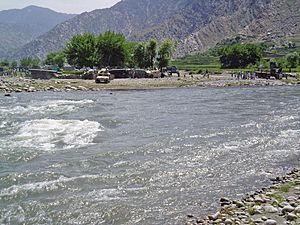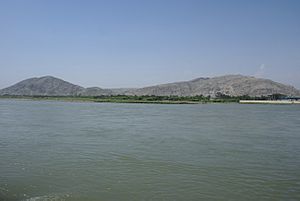List of rivers of Afghanistan facts for kids
Afghanistan is a country with many mountains and dry areas, but it also has important rivers. These rivers are like lifelines, bringing water to people, farms, and animals. They help grow crops and provide drinking water. Rivers in Afghanistan flow in different directions, some ending up in big seas, and others flowing into special areas called endorheic basins, where the water stays within the land and doesn't reach the ocean. This article will tell you about the main rivers in Afghanistan and where their waters go.
Contents
Rivers Flowing to the Arabian Sea
Some of Afghanistan's rivers eventually reach the Arabian Sea, which is part of the Indian Ocean. This happens because these rivers join larger river systems that flow all the way to the coast. The most famous of these is the Indus River system.
- Indus River (Pakistan): While the Indus River itself doesn't flow through Afghanistan, many Afghan rivers are its tributaries. This means they flow into the Indus River, which then carries their water to the Arabian Sea.
- Gomal River: This river starts in Afghanistan and flows into Pakistan, eventually joining the Indus.
- Kundar River: A smaller river that joins the Gomal.
- Zhob River: Another river that flows into the Gomal.
- Kurram River: This river also begins in Afghanistan and flows into Pakistan.
- Kabul River: This is a very important river in eastern Afghanistan. It flows through the capital city, Kabul, and then into Pakistan to join the Indus River.
- Bara River: A tributary that flows into the Kabul River.
- Kunar River: A large river that joins the Kabul River. It's known for its strong currents.
- Pech River: A river that flows into the Kunar River.
- Landai Sin River: Another river joining the Kunar.
- Surkhab (Kabul)|Surkhab: This river also flows into the Kabul River.
- Alingar River: A river that contributes water to the Kabul River.
- Panjshir River: Famous for the Panjshir Valley, this river joins the Kabul River.
- Ghorband River: A tributary of the Panjshir River.
- Gomal River: This river starts in Afghanistan and flows into Pakistan, eventually joining the Indus.
* Salang River: A smaller river that flows into the Ghorband.
-
-
- Logar River: This river flows through the Logar Province and joins the Kabul River.
-
Rivers Flowing into Endorheic Basins
An endorheic basin is like a giant bowl in the land where water collects but doesn't flow out to the ocean. Instead, the water either sinks into the ground or evaporates. Afghanistan has several of these special basins.
Sistan Basin
The Sistan Basin is a large area that stretches across parts of Afghanistan and Iran. Rivers flowing into this basin are crucial for the people living there.
- Harut River (or Ardaskan River): This river flows into the Sistan Basin.
- Farah River: Another important river that feeds the Sistan Basin.
- Helmand River: This is the longest river in Afghanistan and one of the most important. It flows into the Sistan Basin, creating wetlands and supporting agriculture.
- Khash River: A tributary of the Helmand River.
- Arghandab River: A major river that joins the Helmand. It's vital for farming in its valley.
- Dori River: A tributary of the Arghandab.
- Tarnak River: This river flows into the Dori.
- Arghistan River: Another river that joins the Dori.
- Dori River: A tributary of the Arghandab.
* Lora River: A smaller river that flows into the Arghistan.
-
- Musa Qala River: A river that flows into the Helmand.
- Tirin River: Another tributary of the Helmand.
- Kaj River: This river also joins the Helmand.
Ab-i Istada
Ab-i Istada is a large, shallow lake in southeastern Afghanistan. It's an endorheic basin, meaning rivers flow into it, but no rivers flow out.
- Ghazni River: This river flows into the Ab-i Istada lake.
- Jilga River: A smaller river that joins the Ghazni.
Karakum Desert
Some rivers in northern Afghanistan flow towards the Karakum Desert in Turkmenistan. Their waters often disappear into the desert sands or are used for irrigation before reaching the main desert areas.
- Harirud: This river forms part of the border between Afghanistan and Iran. It flows towards the Karakum Desert.
- Jam River: A tributary of the Harirud.
- Murghab River (Afghanistan)|Murghab River: This river also flows towards the Karakum Desert.
- Kushk River: A river that joins the Murghab.
- Kashkan River: Another tributary of the Murghab.
Aral Sea Basin
The Aral Sea is a large inland sea (or lake) in Central Asia. While it has shrunk a lot over the years, some rivers from Afghanistan used to, or still do, contribute to its basin.
- Amu Darya: This is a very large river that forms much of Afghanistan's northern border with Tajikistan, Uzbekistan, and Turkmenistan. It's one of the longest rivers in Central Asia and historically flowed into the Aral Sea.
- Sari Pul River: This river used to reach the Amu Darya, but now its water is often used up before it gets there.
- Balkh River: Similar to the Sari Pul, this river no longer regularly reaches the Amu Darya.
- Khulm River (formerly Tashkurgan River): This river also often doesn't reach the Amu Darya anymore.
- Kunduz River (or Surkhab River): A significant river that flows into the Amu Darya.
- Khanabad River: A tributary of the Kunduz River.
- Andarab: This river flows into the Kunduz.
- Bamiyan River: A river that joins the Kunduz.
- Kokcha River: This river flows into the Amu Darya.
- Anjuman (stream)|Anjuman: A stream that joins the Kokcha.
- Panj River: This river forms a large part of the border between Afghanistan and Tajikistan. It's a major tributary of the Amu Darya.
- Aksu (Bartang): A river that flows into the Panj.
- Pamir River: This river flows into the Panj, high in the mountains.
- Wakhan River: Another river that joins the Panj.
- Shirin Tagab River: This river no longer reaches the Amu Darya.
- Shor Darya River: A tributary of the Shirin Tagab.
Images for kids
See also
- List of dams and reservoirs in Afghanistan
- Water supply in Afghanistan








